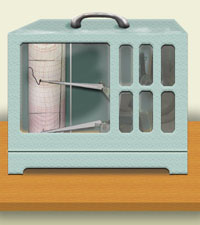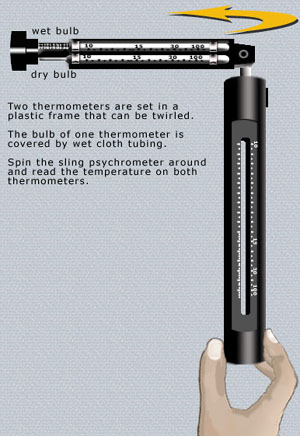
 |
Passive Climate ControlBecause of high energy costs and the impracticality of HVAC for many libraries and archives, there is now a great deal of interest in passive climate control systems. In tropical climates, HVAC can have serious detrimental effects, especially if it cannot be operated on a continuous basis. Generally, HVAC is used to cool spaces, but in climates with very high humidity it does not function well enough as a dehumidifier to ensure effective climate control, and must often be used in combination with dehumidifiers. When HVAC cannot be used continuously—for example, when it is shut down at night or on weekends—the air heats up and condensation forms on the colder surfaces of books, shelves, and walls, resulting in mold growth. Another problem is using HVAC to maintain a lower temperature and humidity
solely in an isolated area of the library or archive, such as a rare-book vault.
When cooler objects are taken from the vault into an uncontrolled area with
a higher temperature and humidity, condensation forms on both the objects and
on the outside wall of the vault, causing mold growth
as well as structural damage to the wall. Sustainable BuildingPassive climate control is associated with the sustainable-building movement, and there has been considerable interest in this area over the last several years with energy costs rising and more attention being paid to environmental issues. Sustainable buildings are designed and constructed in ways that achieve energy savings and a tolerable internal climate. They are located on sites that offer a good microclimate and are designed to regulate heat gain and loss (for example, through passive solar design) and to regulate and improve air circulation. When designing a sustainable building, important issues to consider are location (for example, the building's orientation relative to prevailing winds and the sun), natural shading (trees, hills, other buildings), shelter (from tropical storms), and structural materials (open, lightweight walls in humid tropical areas, thick walls in arid tropical areas).
Correcting Design FaultsThough many libraries and archives are in existing buildings of poor design, steps can be taken to reduce heat intake and light damage and significantly improve air circulation. Unfortunately in some cases, buildings constructed before the age of HVAC are being replaced with sealed "modern" buildings. The traditional building often functions well and is responsive to local conditions, while the sealed modern building, if it has a poorly functioning HVAC, cannot usually accommodate local conditions. Good air circulation can be the key to maintaining a tolerable climate, as moving air reduces humidity and discourages mold.In some cases, existing buildings have other design faults resulting in serious environmental problems. A common problem is "rising damp," a condition where ground moisture is conducted up through a masonry wall or a concrete floor slab. Moisture can damage shelving and increase humidity in the building. In the case of a masonry wall, a damp course can mitigate this problem. A
damp course is a waterproof barrier placed across a section of the wall just
above ground level to prevent moisture rising through the porous masonry. In
the case of a concrete slab, a waterproof membrane between the soil and the
concrete can help. The following steps can be considered when attempting to
improve the climate of a building that lacks HVAC: MonitoringThe continuous monitoring of temperature and humidity is extremely important whether or not the library/archive has climate control systems. In buildings with an HVAC system, its performance can be monitored and corrective action taken when needed. If the library does not have an HVAC system, an accurate record of temperature and humidity through all seasons and conditions can provide the essential data for designing a future system and can indicate where and when remedial action should be taken.Monitoring at its simplest consists of taking regular readings of a thermometer and a hygrometer, calibrated with a psychrometer, and noting the changes throughout the day. Although there are now sophisticated instruments for checking temperature and humidity—such as hand-held electronic hygrometers that measure both—these tend to be labor-intensive and not used at night or during holidays. This is also the disadvantage of basic thermometers, dial-type hygrometers, and humidity strips. Automatic monitors, such as recording hygrothermographs and electronic data-loggers, are more useful. Recording hygrothermographs A recording hygrometer is an instrument that records temperature and humidity by inscribing the levels with pens on a paper chart fastened to a rotating drum. The drum can be powered by clockwork, battery, or directly from an electrical power supply. There are various designs, but all feature charts that are marked into hours, days, and weeks. The pens are attached to levers, which are activated by metallic thermometer and hair bundles or diaphragms. The hair or diaphragm stretches or contracts to measure humidity, while a pen records the level and rate of fluctuation on the moving chart. A recording hygrometer is an instrument that records temperature and humidity by inscribing the levels with pens on a paper chart fastened to a rotating drum. The drum can be powered by clockwork, battery, or directly from an electrical power supply. There are various designs, but all feature charts that are marked into hours, days, and weeks. The pens are attached to levers, which are activated by metallic thermometer and hair bundles or diaphragms. The hair or diaphragm stretches or contracts to measure humidity, while a pen records the level and rate of fluctuation on the moving chart.
The advantage of the recording hygrothermograph is that, if properly used, it provides a graphic and long-term record of conditions. Maintenance can be onerous and must be performed assiduously if an accurate record is to be kept. The paper charts must be collected and changed every week, the two pens charged with ink, the hair bundles or diaphragm regularly replaced because of wear and tear. At least monthly, calibration with a psychrometer must be done.
Psychrometer A psychrometer has two built-in thermometers to determine humidity. One thermometer (the dry bulb) measures the ambient (room) temperature, and the other thermometer (the wet bulb) is wrapped in an absorbent material moistened with distilled water. To obtain a reading, air is passed through the psychrometer to evaporate moisture on the wet bulb. The rate or speed of evaporation is conditioned by the amount of moisture in the air. When the moisture has evaporated, a reading of the temperature on the wet bulb is taken, as the process of evaporation will have cooled it. The readings on the dry bulb thermometer and the wet bulb thermometer are then compared and used to determine the actual humidity. A psychrometer has two built-in thermometers to determine humidity. One thermometer (the dry bulb) measures the ambient (room) temperature, and the other thermometer (the wet bulb) is wrapped in an absorbent material moistened with distilled water. To obtain a reading, air is passed through the psychrometer to evaporate moisture on the wet bulb. The rate or speed of evaporation is conditioned by the amount of moisture in the air. When the moisture has evaporated, a reading of the temperature on the wet bulb is taken, as the process of evaporation will have cooled it. The readings on the dry bulb thermometer and the wet bulb thermometer are then compared and used to determine the actual humidity.
There are several types of psychrometer, the most popular for libraries and archives being the sling version, which is the least expensive and easiest to operate. The instrument is rapidly spun for several minutes to impel air through it. Psychrometers must themselves be calibrated from time to time, and procedures must be followed to the letter in order to obtain reliable information. Misreadings can be caused by over-wetting the bulb, under-rotating the sling, exposing the instrument to strong light, and handling the instrument without gloves.
Data-LoggersA relatively recent innovation, the data-logger is rapidly growing in popularity among librarians and archivists because of its cost (lower than the cost of a hygrothermograph), convenience, and adaptability. Data-loggers range from simple battery-operated devices that register temperature and humidity and must be regularly downloaded into a computer to sophisticated instruments that are connected to the Internet and can monitor factors such as temperature, humidity, light intensity, and pollutants.
|
| Home | Assessment | Contents | Glossary | Vendors | FAQ | Downloads | |
| © 2005 Cornell University Library | Acknowledgements | Feedback | |
| Support for this tutorial comes from the National Endowment for the Humanities |